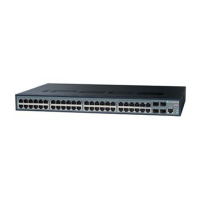
Do you have a question about the iPECS ES-3052G and is the answer not in the manual?
| Switching Capacity | 104 Gbps |
|---|---|
| Forwarding Rate | 77.4 Mpps |
| Power over Ethernet (PoE) | Yes |
| PoE Budget | 370 W |
| MAC Address Table Size | 16K |
| VLANs | 4K |
| Jumbo Frame | 9K Bytes |
| Power Supply | 100-240V AC, 50/60Hz |
Defines symbols and notes used in the guide.
Lists other relevant documentation for the switch.
Provides an overview of the switch's features and capabilities.
Covers connecting to the switch and basic setup procedures.
Explains how to configure IP addressing for network management access.
Describes how to configure SNMP for network management applications.
Covers upgrading software, configuration files, and setting startup files.
Introduces the embedded HTTP web agent for switch configuration.
Guides users on accessing and navigating the web interface.
Describes the selections available in the onboard web agent's main menu.
Shows basic system description, including contact information.
Enables support for jumbo frames to improve throughput for large data transfers.
Covers upgrading software, configuration files, and setting startup files.
Details manual and SNTP-based configuration of the switch's internal clock.
Explains how to restart the switch immediately, at a specified time, or periodically.
Covers configuring connection settings like speed, duplex, and flow control.
Guides on enabling/disabling interfaces and setting capabilities per port.
Sets up mirroring of traffic from source ports to a target port for analysis.
Describes how to configure static and dynamic trunks for increased bandwidth.
Enables power savings mode on selected ports to reduce power consumption.
Covers configuration of static and dynamic VLANs for network segmentation.
Guides on creating or removing VLAN groups and setting administrative status.
Details configuring port members for selected VLANs, including tagging and filtering.
Explains enabling GVRP for automatic VLAN registration across switches.
Configures QinQ tunneling for service providers to maintain customer VLANs.
Allows configuring VLAN groups based on specified protocols for logical segmentation.
Configures static MAC addresses bound to specific interfaces or ports.
Sets the aging time for entries in the dynamic address table to age out forwarding info.
Mirrors traffic matching a specified source MAC address to a target port.
Explains Spanning Tree Algorithm's role in detecting and disabling network loops.
Configures global bridge settings for STP, RSTP, and MSTP across the switch.
Configures interface attributes for STA, including priority, path cost, and edge port.
Guides on creating MSTP instances and grouping VLANs into MSTP instances.
Sets input and output rate limits for ports to control traffic flow.
Configures thresholds for broadcast, multicast, and unknown unicast traffic storms.
Configures thresholds and responses for broadcast/multicast storms.
Covers configuring default priority, queue mode, and weights for egress queues.
Selects packet processing methods (DSCP/CoS) and sets per-hop behavior.
Describes QoS classification criteria and service policies using DiffServ.
Creates a map to identify and classify specific types of traffic.
Defines policy maps for monitoring traffic and setting actions for conforming/non-conforming traffic.
Binds a configured policy map to an ingress port for QoS enforcement.
Recommends isolating VoIP traffic for higher voice quality and security.
Configures switch for VoIP traffic, including auto-detection and Voice VLAN settings.
Identifies VoIP devices by configuring OUI numbers in source MAC addresses.
Configures ports for VoIP traffic, setting mode, discovery method, and priority.
Provides the framework for configuring access control using Authentication, Authorization, Accounting.
Specifies local or remote authentication methods for management access.
Controls network access by authenticating device MAC addresses with a RADIUS server.
Enables secure (SSL) access to the switch's web interface.
Provides secure replacement for Telnet for remote management access via SSH.
Provides packet filtering for IPv4/IPv6 frames based on various criteria.
Creates and configures standard IPv4 Access Control Lists for packet filtering.
Validates MAC Address bindings for ARP packets to protect against man-in-the-middle attacks.
Creates lists of IP addresses allowed for management access to the switch.